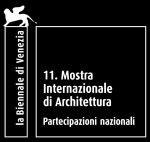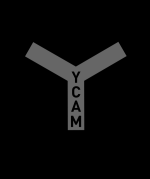Kazunao Abe: On the visibility of architecture…
On the visibility of architecture, and its informational perception
What does the Site in “Corpora in Si(gh)te” (hereafter CiS) indicate? I would like to begin with reasoning behind the approach to this project. As for the Site, it exists as a site-specific architectural form (a form like a prothallium plant) that has dialogue with the environment then and there in real time. What is another meaning of Sight? There is definitely a relatively passive meaning in that this architectural form begins to visually exist only in the presentation making full use of the new software by informational equipment. If Sight is interpreted as having a radical meaning, Corpora “in Sight” means that an architectural form itself has a visual function. Architecture surely appears in vision. There is no architecture without visibility, but I wonder if there has ever been any architecture that is able to see itself. The subject that sees architecture has always been outside. How will the meaning that CiS’s vision brings about change the architectural paradigm?
The theme of CiS is how to approach information technologies as the essential issue of architecture, and I think that it has three important elements that are greatly different from conventional architecture. The first point is that this architecture autonomously generates itself in response to the environment. Secondly, it adopts a new spatial notation in the structure. Lastly, the architecture has internal observational awareness of the environment (including itself and the surroundings). The vision that functions in CiS is prescribed both by the environment and by its own notation system that functions to construct its own information autonomy. This adopted system is the notation by polar coordinates and internal observational vision, uniquely conceived by doubleNegatives Architecture (hereafter dNA). About 10 years ago, dNA started research on this notation, and later conceived of architecture=corpora using generative information. For the first time in this project, these two elements have been combined and constant generation and change have been established through realtime information processing. This conclusion=goal was set up through repeated discussions about the system construction of information processing among dNA, Yamaguchi Center for Arts and Media [YCAM], and myself as a curator, and CiS has been finally realized.
There are various notations to describe a certain world, and the most of them are of the structure in which an observer’s eye is set on a universal, fixed point to catch an object from the outside. The existence of a human being has always been compared to the position of this eye. This eye might be replaced with god or mind. Let me call it an “eye and mind” model. It is possible to examine various viewing angles (for example, transcendental idealism or the phenomenology of the living world, etc.) through this model, but the position of this eye is unchangeable. It remains in the field of philosophy but also involves objective molding of arts such as painting, sculpture, and architecture. Although the forms and modes of objects vary in many different ways, the “eye and mind” model has been maintained.
Due to the emergence of the explosive information society in the 1990s, however, we are forced to discard the “eye and mind” model. The world that information creates is like an endless fabric without the central point. You might call it new environment of second nature. Gregory Bateson carelessly stated “mind in nature” instead of “mind and nature.” This radical misstatement provoked information society and networking to be realized. Bateson states, “you have to clarify the difference between ‘map’ and ‘territory’ first before you draw any map.” The information society based on the networking that is generating today serves as a new territory instead of a map. What is important is not to question minutely if the natural environment and information environment are considered to be equal as territory, but whether or not having to perform interfacing opened to that environment will lead to the discard of conventional eye and mind model. Because keeping away the eye and mind model eventually upsets the existence of artworks and architecture.
Since CiS is always performing self-generational renewal by cell automaton, production and collapse are progressing simultaneously. (It is exactly Piranesi’s prison fantasies in baroque age that continue to change with generative production and collapse at the same time.) Furthermore, the connecting point of each stroke serves as a node point, and at the same time, that point becomes a number of eyes for the internal observation of the self. Self-images as many as the number of nodes are continuously redrawn simultaneously. (Today’s information processing capability has made it possible.) There is no mind in this eye, and it functions as arranged vision. This idea that every existing thing is considered equal as a dynamic existence in the environment is close to Ecological Optics in the context of James J. Gibson’s affordance theory. You might call it Info-Ecological Optics. Mind exists not in the eye but in the whole environment. If architecture is not based on the environment, but inherent in the environment, it will have vision of the mindless eye as CiS does. I won’t forget that the name dNA gave to the original notation at the beginning stage was “smooth compound eye”. The eye is a compound eye and an insect’s eye. There is not mind, but there is only “machinic phylum” that Deleuze and Guattari remarked.
As for the task of CiS at the present stage, immaterial architecture generated by the original information processing system is constructed only by the structure having points and lines. When it obtained the visibility of the surface=mapping, it would have another kind of visibility and function in the living world. In addition, I have an impression that the arrangement structure, which all strokes produce, remains in particulars, not yet functional, due to the emphasis on the equivalence in the environment. It would be questioned whether the creation of function by coding or algorithm through information processing can establish design that goes beyond saturation of the world generated by conventional visual forms based on the eye and mind model. What would be questioned further is whether mutual friction among the functions can conceive new arrangement. If the details could develop the partial functions without destroying the method of details as the whole, that would probably make a new proposition. Further¬ more, CiS’s distinctive merit is that it can adjust differences of scale in strokes. It would create an impression of Fuller Domes of different scales which function as dynamic forms in a Fuller Dome. The plan for this Venice Project is 3-phased Corpora having three levels: one level for around Hungarian pavilion of Gialdini de Castello, another level for the whole city of Venice and the third level covering the whole Italy. Three corpora generated and networked simultaneously through the analysis of the respective environmental data is possible. Now an architectural form for the sake of communication of communication is being conceived.
“Taking into account that the communicative fabric of the living world is ordered, pervasive, and determinant even to the point where one might say of it: that is what men have meant by God”1 , we will take a step forward carefully, trying to describe regularity, to search for patterns and gaps of the fabric.
translated from Japanese by Miki Nishizawa
- G. & M.A. Bateson, Angels Fear: Towards an Epistemology of the Sacred” 1987 [↩]








Leave a Reply
You must be logged in to post a comment.